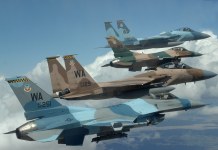Chinese analysts are skeptical about the Russian Su-57 fighter jet, but at the same time are not shy from admitting that they could learn a lot from the Russian stealth jet in terms of some of its capabilities.
An article in the Chinese military’s English-language news site Chinamil.com appeared to shower both praise and disdain for the Russian Sukhoi Su-57.
“The Su-57, Russia’s fifth-generation fighter jet comparable to China’s J-20 and the US’ F-22, is usually considered not a true fifth-generation jet because of its ‘below-standard’ stealth capability, according to media reports,” the website claimed.
“This makes it at a significant disadvantage against Chinese and US counterparts, some military observers said.”
Then the article goes on to quote the chief designer of the state-owned Shenyang Aircraft Design Institute Wang Yongqing saying, “the Su-57’s overall capability is not bad at all.”
Shenyang is a major Chinese defense company, having built several fighters for the country, including the J-11 and J-16, the J-15 carrier jet, and the F-31 stealth fighter.
Chinamil.com quotes Wang, who wrote this in China’s Aerospace Knowledge magazine, “Having an innovative aerodynamic design and capable of thrust vectoring control, the Su-57 attaches strong importance to supersonic cruise capability and super-maneuverability, and stealth is intentionally a second priority.”
He believes that the “US’ concept of next-generation aerial battle stresses beyond visual range attacks, but missiles capable of delivering such attacks have to travel for a while, a time window far enough for the Su-57 to make super-maneuvers and evade them.
Wang says the presence of special radars in the Russian fighter for detecting the precise location of incoming missiles will give it an edge.
Equipped with the world’s first side-facing radars in along with the front-facing ones, Wang said that when combined with infrared sensors Su-57 can detect stealth aircraft very early in their flight.
At the same time, the Chinese military website says that the country has a long tradition of purchasing Russian warplanes, “but as the country developed its own fifth-generation fighter jet, it does not need to buy the Su-57.”
This observation that the Chinese stealth J-20 fighter is far capable than anything Russian has surprised military analysts since the Chinese jet had been using Russian engines after the country’s own WS-15 engines were found unreliable.
The fact that this article appeared on a Chinese military website led military analysts to believe that the country could be interested in buying Su-57 or some of its technologies from Russia.
China has already bought a number of aircraft from Russia, along with S-400 air defense systems, and the two countries are growing their military partnership against the Quad group of countries.
The Russian-origin single-seat, twin-engine Su-57 multirole aircraft took its maiden flight 10 years ago but has still not entered service.
India was one of the countries looking to acquire the aircraft, but delays in its development have marred the process. For now, the only customer that has ordered the aircraft is the Russian defense ministry itself, having ordered 76 fighters which will be delivered in 2028.
Su-57 is built for super-cruise, super-maneuverability, stealth, and advanced avionics to outpace the fourth-generation fighters. During the same time, China designed and developed its own fifth-generation stealth fighter J-20, which is a single-seat, all-weather fighter and built as a competitor to the American stealth pair of F-35 Lightning and F-22 Raptor.
Experts have determined the Su-57 fighter to be superior to its Chinese counterpart in terms of overall kinematic performance. The future second stage Saturn Izdeliye 30 engines, which will power the Su-57 fighters in the future, are expected to deliver roughly 28,000lbs of dry thrust and 42,000lbs of afterburning thrust.
The resultant kinematic performance—including supersonic cruise and maneuverability—achieved would roughly be on par with the Lockheed Martin F-22 Raptor, experts say.
Other experts say the two jets can’t be compared as they are designed to perform different roles, with J-20 acting as a stealth missile platform to penetrate sophisticated enemy air defenses with an aim to destroy military installations.
Whereas, the Russian Su-57 is more of an air superiority platform, excelling in close-combat warfare.
Follow EurAsian Times on Google News




